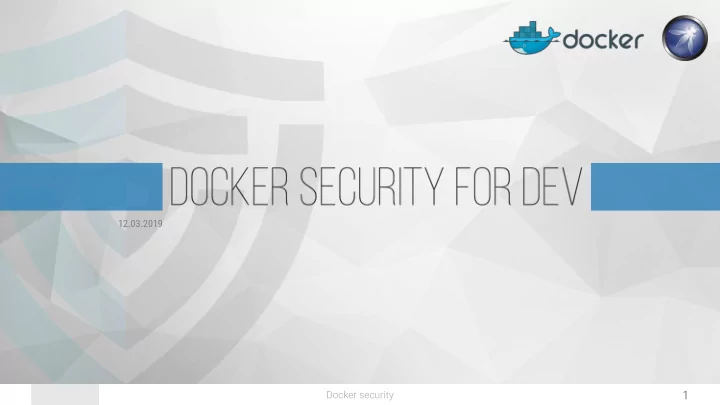

12.03.2019 Docker security 1
Agenda Docker world Containers VS Virtual machine Security concerns Conclusion
Whoami ➔ M.Sc Computer Security ➔ M.Sc Software Development ➔ Worked previously as an embedded software developer ➔ Actually working at ImmunIT ➔ Pentesting ➔ Secure coding training ➔ Security awareness training ➔ Social Engineering ➔ Project Management ➔ R&D developer
Docker security 4
What is docker? Containerization Operating-system-level virtualization Execution environment virtualization
What is docker?
What is docker?
What is docker?
Why using docker? ➔ Isolate services ➔ Simplify micro-services enhancement and maintenance ➔ Avoid dependency issues ➔ Allow to execute untrusted code safely ➔ Reduce risks involved by a compromise ➔ etc
How it works?
Docker basics
Dockerfile & docker-compose Dockerfile ➔ Defines a docker image
Dockerfile & docker-compose Docker-compose ➔ Defines a containers stack ➔ Overwrite Dockerfile behaviors
Orchestration ➔ Automates image buildings ➔ Automates deployment ➔ Resilient ➔ Macro management ➔ Live metrics
Orchestration Orchestrators
Orchestration Registry & rancher
Orchestration Rancher overview
Orchestration Rancher overview
Orchestration Rancher overview
Containers VS Virtual Machine The millennial war Docker security 20
Containers VS Virtual Machine Virtual Machine! Containers!
Containers VS Virtual Machine
Containers VS Virtual Machine
Security concerns Docker security 24
Kernel namespace ➔ Containers process are running in their own kernel namespace ➔ Provides segregation ➔ Decreases risk exposure ➔ Containers get their own network stack
User namespace ➔ Best way to prevent privilege escalation attack ➔ Configured on the host level ➔ Prevent root usage
Tools Docker notary ➔ Verify image signature ➔ Ensure integrity ➔ Avoid backdoors ➔ Cross platform
Tools Docker notary
Tools Docker bench security
Tools Traefik
Tools CoreOS
Tools Dockscan
Container hardening & Access Control Management
Container hardening & Access Control Management Seccomp
Container hardening & Access Control Management SE Linux
Container hardening & Access Control Management App Armor
Flags Volume vs mount vs tmpfs
Flags Winner is volume ➔ Easier to back up ➔ Can be managed through the docker CLI ➔ Cross-platform ➔ Safe sharing ➔ Remote volume ➔ Data encryption (LVM, LUKS)
Flags Winner is volume ➔ Avoid mounting sensitive folder ➔ Use ro flag when needed
Flags Privileged container ➔ Privileged container run as a proper OS --privileged is evil ➔ Can modify interfaces / iptables ➔ Access host devices
Flags Security opt
Flags Network namespace
Flags Network namespace ➔ Use dedicated networks ➔ Isolate containers on separated networks ➔ Create networks for exposed containers ➔ Segregate and segment networks as your own internal network
Ports exposure ➔ Control services exposure ➔ Do not expose unnecessary ports
Ports exposure EXPOSE keyword is overwritten by – p flag at runtime Docker run – rm – it – p 0.0.0.0:1337:80 alpine Docker run – rm – it – p 127.0.0.1:1337:80 alpine
How to avoid Denial of Service attack
How to avoid Denial of Service attacks By default, a container has no resource constraints and can use as much of a given resource as the hosts’s kernel scheduler will allow
How to avoid Denial of Service attacks Memory usage
How to avoid Denial of Service attacks CPU usage
Conclusion Docker security 50
Best practices ➔ Harden your containers ➔ Isolate your containers ➔ Keep up to date the underlying operating system ➔ Use security tool to monitor your containers
Conclusion Consider your containers as any physical machine and ensure their compliance towards your company security policies
Docker security 53
QUESTIONS ? Docker security 54
Recommend
More recommend